Encyclopedia Dubuque
"Encyclopedia Dubuque is the online authority for all things Dubuque, written by the people who know the city best.”
Marshall Cohen—researcher and producer, CNN
Affiliated with the Local History Network of the State Historical Society of Iowa, and the Iowa Museum Association.
BOAT BUILDING: Difference between revisions
No edit summary |
No edit summary |
||
| Line 17: | Line 17: | ||
Iowa Iron Works of Dubuque constructed craft for every use. The King of Siam ordered an iron yacht that was delivered to him in 1876. The "Queen" was launched in 1884 for excursions on northwest Iowa's Lake Okoboji and was still in use through the 1960s. | Iowa Iron Works of Dubuque constructed craft for every use. The King of Siam ordered an iron yacht that was delivered to him in 1876. The "Queen" was launched in 1884 for excursions on northwest Iowa's Lake Okoboji and was still in use through the 1960s. | ||
The "J. K. Graves," launched in 1885 by the Iowa Iron Works, was a giant raft-boat used to push rafts of logs to the mills. Steel-hulled packets for carrying freight and passengers included the "Cherokee," the company's first boat of this type. The "Cherokee" boasted electric lights and the capability of carrying up to one thousand passengers. Constructing the "Ferdinand Herold" required 125 workers and cost $80,000. Railroad ferries with track laid on the deck were constructed to transport trains across the Mississippi where bridges were temporarily out of service | The "J. K. Graves," launched in 1885 by the Iowa Iron Works, was a giant raft-boat used to push rafts of logs to the mills. Steel-hulled packets for carrying freight and passengers included the "Cherokee," the company's first boat of this type. The "Cherokee" boasted electric lights and the capability of carrying up to one thousand passengers. Constructing the "Ferdinand Herold" required 125 workers and cost $80,000. Railroad ferries with track laid on the deck were constructed to transport trains across the Mississippi where bridges were temporarily out of service. | ||
[[Image:boats-1.gif|left|thumb|150px|"Willow"]]Willow, a 200-foot, 1,070 ton, side paddlewheel river tender, was built by the Dubuque Boat & Boiler Works for the US Lighthouse Service for service on the Mississippi River. Commissioned in 1924, she was decommissioned and transferred to the Army Corps of Engineers in 1945. Her maximum speed was 7.5 knots and her economic cruising speed was a 4.0 knots. She was stationed at Memphis. At an average construction cost of $250,000 each, the "L. S. Thorne" (1898), "Pelican" (1902), "Albatross" (1907) and "B. F. Yoakum" (1910) and the “Willow” (1924) were important contributors to the Dubuque economy. | |||
[[Image:boats-1.gif|left|thumb|150px|]]Willow, a 200-foot, 1,070 ton, side paddlewheel river tender, was built by the Dubuque Boat & Boiler Works for | |||
Concern about the condition of the U.S. Navy led to Congressional calls for modernization at the end of the nineteenth century. In 1891 the Iowa Iron Works received the contract to build Torpedo Boat No.2. Named the "Ericsson," the boat was outfitted with state-of-the-art equipment and saw service during the Spanish-American War. | Concern about the condition of the U.S. Navy led to Congressional calls for modernization at the end of the nineteenth century. In 1891 the Iowa Iron Works received the contract to build Torpedo Boat No.2. Named the "Ericsson," the boat was outfitted with state-of-the-art equipment and saw service during the Spanish-American War. | ||
During the trial runs of the "Ericsson," the pistons broke because they had been built too light. The Navy penalty of $17,000 forced the company out of business. Senator [[ALLISON, William Boyd|William ALLISON]] rescued the firm by attaching an amendment to an appropriations bill stating that the Navy would repay the money to the bankrupt Dubuque company. The repayment was used in 1904 to reorganize the company as the [[DUBUQUE BOAT AND BOILER WORKS]]. | During the trial runs of the "Ericsson," the pistons broke because they had been built too light. The Navy penalty of $17,000 forced the company out of business. Senator [[ALLISON, William Boyd|William ALLISON]] rescued the firm by attaching an amendment to an appropriations bill stating that the Navy would repay the money to the bankrupt Dubuque company. The repayment was used in 1904 to reorganize the company as the [[DUBUQUE BOAT AND BOILER WORKS]]. | ||
--- | --- | ||
Revision as of 20:58, 6 March 2014
BOAT BUILDING. The geographic location of Dubuque midway between St. Louis and St. Paul and the protected harbor (claimed by river pilots as the Upper Mississippi's best), were important reasons for the development of the ship manufacturing industry.
Dubuque pioneered the evolution of boats from wooden hulls to iron. In 1870 the first keel was laid for an iron vessel in Dubuque. The manufacturer, IOWA IRON WORKS, named this steamboat the "Clyde," for the home in Scotland of William HOPKINS, a builder of ironclads during the CIVIL WAR and master mechanic. The 96-foot-long Clyde, the first iron-hulled boat built for the Upper MISSISSIPPI RIVER, was the second boat built for the logging trade.
In 1871 the Iowa Iron Works constructed the Dubuque Marine Ways, the largest boatyard of its kind north of St. Louis and considered the best on the Mississippi River, at EAGLE POINT. Iron and steel, supplied by its foundry on 9th and Washington STREETS, were carried to the river for assembly during the thirty-seven-year life of the business.
In 1874 Joseph "Diamond Joe" REYNOLDS established a boatyard at Eagle Point for constructing wooden-hulled steamers. Employing as many as one hundred workers, the company created an increased demand for lumber, timber, hardware, iron work and castings. (1)
Of these yards, the Iowa Iron Works developed as the major boat builder in the city.
Over many years, improvements were made to increase the potential value of the Dubuque ICE HARBOR. The enhanced site led in 1895 to the Iowa Iron Works relocating their shipyard there.
In 1901 a contract was signed for the construction of the "SPRAGUE," the largest steam stern wheel towboat in the history of the Mississippi. Despite the death in 1902 of William Hopkins, the year proved the company's best with the Sprague nearly completed and the keel laid for the "Pelican," an enormous transfer steamboat.
Iowa Iron Works of Dubuque constructed craft for every use. The King of Siam ordered an iron yacht that was delivered to him in 1876. The "Queen" was launched in 1884 for excursions on northwest Iowa's Lake Okoboji and was still in use through the 1960s.
The "J. K. Graves," launched in 1885 by the Iowa Iron Works, was a giant raft-boat used to push rafts of logs to the mills. Steel-hulled packets for carrying freight and passengers included the "Cherokee," the company's first boat of this type. The "Cherokee" boasted electric lights and the capability of carrying up to one thousand passengers. Constructing the "Ferdinand Herold" required 125 workers and cost $80,000. Railroad ferries with track laid on the deck were constructed to transport trains across the Mississippi where bridges were temporarily out of service.
Willow, a 200-foot, 1,070 ton, side paddlewheel river tender, was built by the Dubuque Boat & Boiler Works for the US Lighthouse Service for service on the Mississippi River. Commissioned in 1924, she was decommissioned and transferred to the Army Corps of Engineers in 1945. Her maximum speed was 7.5 knots and her economic cruising speed was a 4.0 knots. She was stationed at Memphis. At an average construction cost of $250,000 each, the "L. S. Thorne" (1898), "Pelican" (1902), "Albatross" (1907) and "B. F. Yoakum" (1910) and the “Willow” (1924) were important contributors to the Dubuque economy.
Concern about the condition of the U.S. Navy led to Congressional calls for modernization at the end of the nineteenth century. In 1891 the Iowa Iron Works received the contract to build Torpedo Boat No.2. Named the "Ericsson," the boat was outfitted with state-of-the-art equipment and saw service during the Spanish-American War.
During the trial runs of the "Ericsson," the pistons broke because they had been built too light. The Navy penalty of $17,000 forced the company out of business. Senator William ALLISON rescued the firm by attaching an amendment to an appropriations bill stating that the Navy would repay the money to the bankrupt Dubuque company. The repayment was used in 1904 to reorganize the company as the DUBUQUE BOAT AND BOILER WORKS.
---
Source:
1. River News, Dubuque Herald, Mar. 22, 1882, p. 4. Online: http://news.google.com/newspapers?id=FpRCAAAAIBAJ&sjid=LqsMAAAAIBAJ&pg=3146,6260675&dq=dubuque+marine+ways&hl=en






